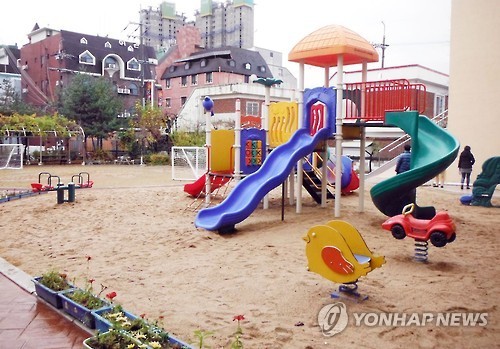South Korean children spend an average of 34 minutes outside each day, significantly less than children in other countries, a study showed Tuesday.
The National Institute of Environmental Research said that Korean children spend less time exposed to nature and are more likely to stay indoors due to time spent on private education and digital technology in their spare time.
The state-run institute questioned 8,000 youths aged 18 and younger between 2013 and 2015 to find out the extent to which children are exposed to the environment.
The study found that the children aged 3-9 spent 34 minutes a day playing outside, less than a third of the time American kids spent (119 minutes). Canadian children played outdoors for 100 minutes each day.

Korean children aged 7-9 spent 36 minutes outdoors per day on average, while they spent twice as long taking extra classes and watching TV, respectively. They spent 34 minutes surfing the Internet.
The lack of outdoor activities is often linked to heightened health risks for children’s mental and physical well-being.
The American Academy of Pediatrics recommends that children spend at least 60 minutes in daily unstructured free play which it called “an essential part of children’s physical and mental health and social development.” The body pointed out that children who play outside are less aggressive and have better concentration, among other health benefits.
Richard Louv, chairman of the Children and Nature Network, noted in his book “Last Child in the Woods” that the disconnection between children and the natural world causes childhood depression, asthma, obesity, vitamin D deficiency and type 2 diabetes.
In terms of the exposure to chemical vapors, fumes or dust in the air, Korean kids aged 5-6 inhaled 10.8 micrograms per cubic meter, while American kids were exposed to 12.16 per cubic meter.
When it comes to food intake, Korean children aged 1-2 consumed 2.35 grams of grains, 7.8 grams of vegetables, 10.9 grams of fruits and 1.9 grams of meat. American children of the same age group, in contrast, took a lot less grains (6.4 grams) and more meat (4.1 grams).
The release of the study in the form of a handbook comes as the state-run environment agency plans to systematically compile data on children’s exposure to environmental risks. The handbook will be distributed to major institutes, universities and libraries, the agency said.
By Ock Hyun-ju (
laeticia.ock@heraldcorp.com)







![[Today’s K-pop] Blackpink’s Jennie, Lisa invited to Coachella as solo acts](http://res.heraldm.com/phpwas/restmb_idxmake.php?idx=644&simg=/content/image/2024/11/21/20241121050099_0.jpg)
